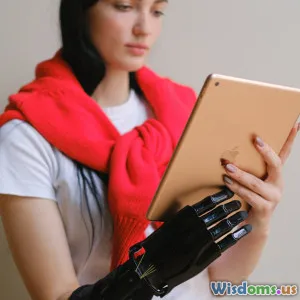
Innovative Futures: AI in Everyday Life
8 min read Discover how AI is transforming everyday life, from smart homes to personalized healthcare, shaping a futuristic reality today. (0 Reviews)
Innovative Futures: AI in Everyday Life
Introduction: From Sci-Fi Dream to Daily Reality
Imagine waking up in a home that anticipates your every need—your coffee brewed exactly how you like it, your thermostat adjusted without a second thought, and even mirrors that offer personalized health advice. For many, this scenario once belonged purely to the realm of science fiction. Today, artificial intelligence (AI) is not only making these visions real but is also redefining the boundaries between the possible and impossible in everyday living.
Across the globe, AI-powered technologies are quietly transforming mundane routines, inspiring groundbreaking innovations that improve quality of life, enhance productivity, and open extraordinary doors for the future. This article explores the incredible ways AI is reshaping our daily lives, from smart homes and healthcare breakthroughs to workplace advancements and entertainment evolution.
Smart Homes: AI Creating Intuitive Living Spaces
Smart homes are perhaps the most tangible example of AI’s integration into everyday life. By leveraging interconnected devices and machine learning algorithms, these homes adapt to their occupants’ preferences, often before they even voice a need.
Personalized Environment Control
Thermostatic AI systems like Google Nest learn residents' temperature preferences over weeks and adjust automatically, showing a 12% average reduction in heating bills according to a 2019 study by Nest Labs. Beyond temperature, smart lighting systems such as Philips Hue adjust brightness and color to mimic natural circadian rhythms, boosting wellness and productivity.
AI and Home Security
AI-driven security cameras and alarm systems use facial recognition and behavioral analysis to differentiate ordinary occupants from intruders. Companies like Ring now integrate AI to minimize false alarms by promptly alerting homeowners to genuine threats.
Voice Assistants as Daily Companions
Voice-activated AI assistants—Amazon Alexa, Apple’s Siri, Google Assistant—have become household staples. Their ability to control devices, schedule reminders, answer questions, and even interact conversationally embodies science fiction made real. The global smart speaker market, driven largely by these assistants, was valued at over $10 billion in 2023 and continues to grow exponentially.
Healthcare Revolution: AI Empowering Personalized Wellness
AI strides in healthcare illustrate how technology can profoundly enhance both diagnostics and patient care, pushing boundaries previously seen only in futuristic narratives.
Early Diagnosis and Predictive Analytics
AI algorithms can analyze vast datasets, identifying subtle patterns impossible for human practitioners to detect. For instance, Google Health’s DeepMind algorithm achieved 94.5% accuracy in breast cancer detection, outperforming human radiologists in some tests. By enabling earlier and more precise diagnosis, AI arms clinicians with tools for timely intervention.
AI in Managing Chronic Diseases
AI-driven apps and wearables monitor conditions like diabetes, heart disease, and asthma in real-time, suggesting immediate lifestyle changes or medication adjustments. According to a 2022 survey by Accenture, nearly 30% of US healthcare providers incorporate AI solutions, citing improvements in patient engagement and outcomes.
Robotic Surgery and Telepresence
Robotic surgical systems like the da Vinci Surgical System, enhanced by AI, improve precision and reduce recovery times. Meanwhile, AI-enabled telemedicine expands access to expert care across geographic boundaries, democratizing specialty healthcare.
Workplace Transformation: AI Enhancing Efficiency and Creativity
In the professional arena, AI catalyzes a revolution not just through automation but by amplifying human creativity and decision-making abilities.
Automating Routine Tasks
AI-powered tools reduce time spent on mundane activities—email sorting, scheduling, data entry—allowing workers to focus on higher-value tasks. In sectors like finance and insurance, robotic process automation (RPA) has cut operational costs by up to 40%, according to McKinsey reports.
AI as a Creative Partner
Emerging AI systems like OpenAI’s GPT series serve as co-creators in fields ranging from content writing to software development and design. Designers use AI to generate concepts rapidly, while authors can brainstorm story ideas, fundamentally altering the creative workflow.
Data-Driven Decision Making
Sophisticated AI analytics provide actionable insights from big data, guiding strategy and innovation. For example, Walmart uses AI to optimize supply chain logistics, contributing to annual savings exceeding $2 billion.
Entertainment and Leisure: AI Crafting Immersive Experiences
From science fiction films to interactive games, AI elevates how we entertain ourselves, crafting personalized and immersive experiences.
Personalized Content Recommendations
Streaming giants like Netflix and Spotify employ AI algorithms to analyze viewing and listening habits, offering custom-tailored suggestions that enhance user engagement. Netflix claims these recommendations save them $1 billion annually by reducing churn.
AI and Virtual Reality (VR)
AI enriches VR environments by simulating intelligent non-player characters (NPCs) and adapting scenarios dynamically to user behavior. This synergy heralds new possibilities in gaming, training simulations, and virtual tourism.
AI-Generated Art and Music
AI algorithms now compose music, generate visual art, and write scripts. Tools like OpenAI’s DALL·E create unique images from textual descriptions, blurring the lines between human and machine creativity. This interplay fosters fresh artistic exploration and dialogue about creativity’s future.
Conclusion: Embracing a Collaborative Future with AI
The integration of AI into everyday life is more than a technological trend; it is a paradigm shift touching every aspect of human existence. From smarter homes and enhanced healthcare to transformed workplaces and enriched leisure activities, AI is not just imitating science fiction—it is actualizing it.
However, as this future unfolds, it invites us to thoughtfully consider ethical frameworks, data privacy, and equitable access to AI benefits. Embracing AI’s power while guiding its development thoughtfully can transform society for the better, making a once-fictional vision tangibly transformative.
As captivating as the future painted by science fiction authors, the AI-driven future offers us tools to not merely imagine but to actively build a world where technology and humanity coexist to unlock unprecedented possibilities. The journey has just begun, and each of us plays a role in shaping this innovative future.
“The future is already here — it’s just not very evenly distributed.” — William Gibson
Rate the Post
User Reviews
Popular Posts




















